13.2.1: Tropical Forests
- Page ID
- 16150
\( \newcommand{\vecs}[1]{\overset { \scriptstyle \rightharpoonup} {\mathbf{#1}} } \)
\( \newcommand{\vecd}[1]{\overset{-\!-\!\rightharpoonup}{\vphantom{a}\smash {#1}}} \)
\( \newcommand{\id}{\mathrm{id}}\) \( \newcommand{\Span}{\mathrm{span}}\)
( \newcommand{\kernel}{\mathrm{null}\,}\) \( \newcommand{\range}{\mathrm{range}\,}\)
\( \newcommand{\RealPart}{\mathrm{Re}}\) \( \newcommand{\ImaginaryPart}{\mathrm{Im}}\)
\( \newcommand{\Argument}{\mathrm{Arg}}\) \( \newcommand{\norm}[1]{\| #1 \|}\)
\( \newcommand{\inner}[2]{\langle #1, #2 \rangle}\)
\( \newcommand{\Span}{\mathrm{span}}\)
\( \newcommand{\id}{\mathrm{id}}\)
\( \newcommand{\Span}{\mathrm{span}}\)
\( \newcommand{\kernel}{\mathrm{null}\,}\)
\( \newcommand{\range}{\mathrm{range}\,}\)
\( \newcommand{\RealPart}{\mathrm{Re}}\)
\( \newcommand{\ImaginaryPart}{\mathrm{Im}}\)
\( \newcommand{\Argument}{\mathrm{Arg}}\)
\( \newcommand{\norm}[1]{\| #1 \|}\)
\( \newcommand{\inner}[2]{\langle #1, #2 \rangle}\)
\( \newcommand{\Span}{\mathrm{span}}\) \( \newcommand{\AA}{\unicode[.8,0]{x212B}}\)
\( \newcommand{\vectorA}[1]{\vec{#1}} % arrow\)
\( \newcommand{\vectorAt}[1]{\vec{\text{#1}}} % arrow\)
\( \newcommand{\vectorB}[1]{\overset { \scriptstyle \rightharpoonup} {\mathbf{#1}} } \)
\( \newcommand{\vectorC}[1]{\textbf{#1}} \)
\( \newcommand{\vectorD}[1]{\overrightarrow{#1}} \)
\( \newcommand{\vectorDt}[1]{\overrightarrow{\text{#1}}} \)
\( \newcommand{\vectE}[1]{\overset{-\!-\!\rightharpoonup}{\vphantom{a}\smash{\mathbf {#1}}}} \)
\( \newcommand{\vecs}[1]{\overset { \scriptstyle \rightharpoonup} {\mathbf{#1}} } \)
\( \newcommand{\vecd}[1]{\overset{-\!-\!\rightharpoonup}{\vphantom{a}\smash {#1}}} \)
\(\newcommand{\avec}{\mathbf a}\) \(\newcommand{\bvec}{\mathbf b}\) \(\newcommand{\cvec}{\mathbf c}\) \(\newcommand{\dvec}{\mathbf d}\) \(\newcommand{\dtil}{\widetilde{\mathbf d}}\) \(\newcommand{\evec}{\mathbf e}\) \(\newcommand{\fvec}{\mathbf f}\) \(\newcommand{\nvec}{\mathbf n}\) \(\newcommand{\pvec}{\mathbf p}\) \(\newcommand{\qvec}{\mathbf q}\) \(\newcommand{\svec}{\mathbf s}\) \(\newcommand{\tvec}{\mathbf t}\) \(\newcommand{\uvec}{\mathbf u}\) \(\newcommand{\vvec}{\mathbf v}\) \(\newcommand{\wvec}{\mathbf w}\) \(\newcommand{\xvec}{\mathbf x}\) \(\newcommand{\yvec}{\mathbf y}\) \(\newcommand{\zvec}{\mathbf z}\) \(\newcommand{\rvec}{\mathbf r}\) \(\newcommand{\mvec}{\mathbf m}\) \(\newcommand{\zerovec}{\mathbf 0}\) \(\newcommand{\onevec}{\mathbf 1}\) \(\newcommand{\real}{\mathbb R}\) \(\newcommand{\twovec}[2]{\left[\begin{array}{r}#1 \\ #2 \end{array}\right]}\) \(\newcommand{\ctwovec}[2]{\left[\begin{array}{c}#1 \\ #2 \end{array}\right]}\) \(\newcommand{\threevec}[3]{\left[\begin{array}{r}#1 \\ #2 \\ #3 \end{array}\right]}\) \(\newcommand{\cthreevec}[3]{\left[\begin{array}{c}#1 \\ #2 \\ #3 \end{array}\right]}\) \(\newcommand{\fourvec}[4]{\left[\begin{array}{r}#1 \\ #2 \\ #3 \\ #4 \end{array}\right]}\) \(\newcommand{\cfourvec}[4]{\left[\begin{array}{c}#1 \\ #2 \\ #3 \\ #4 \end{array}\right]}\) \(\newcommand{\fivevec}[5]{\left[\begin{array}{r}#1 \\ #2 \\ #3 \\ #4 \\ #5 \\ \end{array}\right]}\) \(\newcommand{\cfivevec}[5]{\left[\begin{array}{c}#1 \\ #2 \\ #3 \\ #4 \\ #5 \\ \end{array}\right]}\) \(\newcommand{\mattwo}[4]{\left[\begin{array}{rr}#1 \amp #2 \\ #3 \amp #4 \\ \end{array}\right]}\) \(\newcommand{\laspan}[1]{\text{Span}\{#1\}}\) \(\newcommand{\bcal}{\cal B}\) \(\newcommand{\ccal}{\cal C}\) \(\newcommand{\scal}{\cal S}\) \(\newcommand{\wcal}{\cal W}\) \(\newcommand{\ecal}{\cal E}\) \(\newcommand{\coords}[2]{\left\{#1\right\}_{#2}}\) \(\newcommand{\gray}[1]{\color{gray}{#1}}\) \(\newcommand{\lgray}[1]{\color{lightgray}{#1}}\) \(\newcommand{\rank}{\operatorname{rank}}\) \(\newcommand{\row}{\text{Row}}\) \(\newcommand{\col}{\text{Col}}\) \(\renewcommand{\row}{\text{Row}}\) \(\newcommand{\nul}{\text{Nul}}\) \(\newcommand{\var}{\text{Var}}\) \(\newcommand{\corr}{\text{corr}}\) \(\newcommand{\len}[1]{\left|#1\right|}\) \(\newcommand{\bbar}{\overline{\bvec}}\) \(\newcommand{\bhat}{\widehat{\bvec}}\) \(\newcommand{\bperp}{\bvec^\perp}\) \(\newcommand{\xhat}{\widehat{\xvec}}\) \(\newcommand{\vhat}{\widehat{\vvec}}\) \(\newcommand{\uhat}{\widehat{\uvec}}\) \(\newcommand{\what}{\widehat{\wvec}}\) \(\newcommand{\Sighat}{\widehat{\Sigma}}\) \(\newcommand{\lt}{<}\) \(\newcommand{\gt}{>}\) \(\newcommand{\amp}{&}\) \(\definecolor{fillinmathshade}{gray}{0.9}\)The Tropical Rain forest
The Tropical Rain forest contains trees standing 30 to 55 meters in height, creating a continuous canopy of foliage. The enclosed canopy shades the forest floor, creating an open forest formation. Few pure stands of trees exist in the rain forest. Instead, individual trees are widely dispersed throughout the forest. Mahogany, teak and other tropical hardwoods are harvested for creating fine furniture. The lush vegetation and great animal diversity should be expected in the tropical rain forest climate.
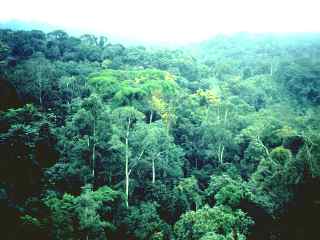
Peering into the canopy reveals a multistory appearance of broad leaf, evergreen vegetation called "selva". The typical three-tiered zonation includes an emergent layer of solitary, giant trees reaching heights of 55 meters (180 ft) for the sunlight they require. Beneath is an intermediate zone (canopy) of continuous foliage 9 to 18 meters (30 to 60 ft) high. The forest floor is relatively open as the shade of the closed canopy inhibits plant growth. It is a damp and dim world as one walks through the aroma of decaying vegetation. Giant woody vines called "lianas" snake their way up the trunks of trees. Epiphytes ("air plants"), like the brilliantly colored bromeliad, grow in the hollows of trees or the upper surfaces of horizontally-growing branches capturing nutrients and moisture from the air.

A cloud forest exists on extremely moist mountain slopes above the elevation of the true rain forest. The cloud forest differs from the rain forest found at lower elevations in that trees are much shorter and the forest floor is virtually impenetrable.
Plants have adapted to this environment in unique ways:
“The canopy itself, the ceiling of the jungle, is a dense continuous layer of greenery some 6 or 7 meters deep. Each leaf is accurately angled to ensure that it will collect the maximum amount of light. Many have a special joint at the base of the stalk that enables them to twist and follow the sun as it swings overhead from east to west each day. All except the topmost layer is screened from the wind, so the around them is warm and humid”.
The Living Planet
D. Attenborough
The rain forest is a treasure trove of different animal and plant species. The numerous species that inhabit the rain forests are not well documented. The intense precipitation of the tropical rain forest climate heavily leaches the soil. Oxisol soil common to the rain forest is relatively infertile due to intense weathering and a lack of available nutrients. Deforestation and habitat destruction is severely crippling the rain forest ecosystem. View the "Secret Life of the Rainforest" provided by the Smithsonian Channel.
Tropical Monsoon/Seasonal Forest and Shrub
The Tropical Monsoon/Seasonal Forest and Shrub contains trees of smaller stature than those found in the rain forest. The Monsoon forest may include deciduous trees, as well as, broadleaf evergreen trees reflecting the seasonal precipitation of the monsoon climate. The trees of the Monsoon Forest have a more open canopy than the rain forest, creating a dense, closed forest at the floor, or what we think of as a "tropical jungle". The thick surface undergrowth makes navigating through the forest difficult. Jungle growth is also found along streams, and in openings created by humans.
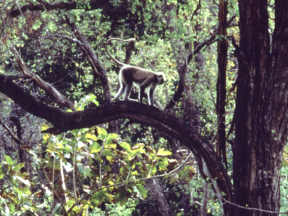
Like the tropical rain forest, the monsoon forest supports a diversity of plant and animal species. And like the rain forest, it's biotic system is being stressed by human activities.
Investigate the effects of human activities on the tropical forest biome by "Digging Deeper: Human Activities and the tropical Forests" or continue to the next topic.
Species Endangerment in the Tropical Forests
Habitat encroachment and destruction have been a primary cause of declining animal and plant species, threatening many with extinction. For example, habitat encroachment and sport hunting has led to the rapid decline of the Bengal tiger and are considered a threaten species. Solitary animals, tigers can weigh up to 500 pounds and measure nine feet in length. The main diet of the tiger consists of deer, antelope, and wild pig.
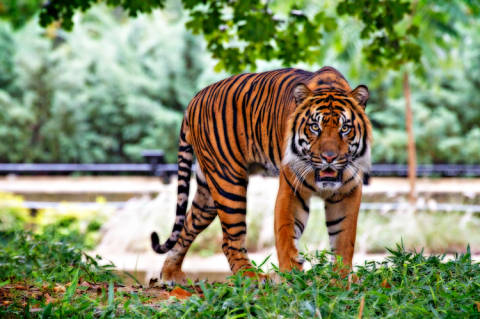
Logging and agriculture in the densely populated countries of southeast Asia have literally squeezed the tiger out of its home. Human encroachment on the tiger's habitat has led to more frequent conflicts between tigers and humans. However, human fatalities from tigers are a result of injured or sick animals to weak to hunt wild animals.
Sport hunting and killing to use body parts for traditional medicines since 1900 has significantly contributed to the decline of the tiger. In the early 1900's it was estimated that 100,000 tigers roamed Asia. In 1900, approximately 40,000 lived in India. By the 1960's this number fell to 4,000. By the early seventies fewer that 2,000 remained in India. Recognizing the potential loss of their national treasure, intensive conservation efforts by the Indian government and the world community has doubled their numbers in recent years. The world-wide population of tigers is estimated to be 5,100 to 7,500 individuals (World Wildlife Fund).
Illegal hunting to support the bush meat trade has taken a devastating toll on animal species. The bushmeat trade ranks among the greatest threats to tropical wildlife according to some environmentalists. Research has shown that increased poaching in Ghana has resulted in significant declines in 41 wild animal species. This research speculates that the bushmeat trade has grown partly in response to over fishing off West Africa by foreign and domestic industrial fleets. With dwindling resources for protein, people turn to the forest for food.
Deforestation in the Tropical Forests
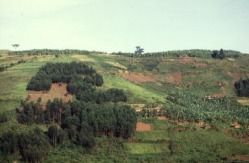
Human activity has drastically altered the natural distribution of forests through history. Deforestation and habitat destruction is severely crippling the rain forest ecosystem. Rain forests are being destroyed at a rate of 78 million acres (31 million hectares) per year; an area larger than Poland. With habitat destruction comes loss of species. The World Resources Institute predicts that deforestation rates of 15 million hectares would reduce species in the closed canopy forests by 35% by 2040. In Brazil, the estimated average rate of destruction between 1979 - 1990 was 5.4 million acres per year. In 2003 a record 10,000 square miles of Brazil was cleared (Lobe, 2004).
Deforestation causes a multitude of effects on the natural environment as shown below. Vegetation is degraded due to a loss of nutrient-rich litter and microorganisms to decompose organic matter. The loss of shade accelerates leaching, soil erosion and drying. The hard surface caused by baking impedes water infiltration causing excess runoff and flooding. In addition to the effect on the local vegetation and hydrology, forest removal impacts atmospheric composition, evapotranspiration, and precipitation.

Soil degradation from forest clearing for agriculture happens quickly. Soil fertility can decrease by 80% in only a few years after forest removal.
Soil fertility loss due to forest clearing (Drew,1983)
|
Land use |
Organic Content |
Cation |
Nitrogen |
Phosphorus |
|---|---|---|---|---|
|
Virgin Forest |
100 |
100 |
100 |
100 |
|
1 Year after clearing, unused |
104 |
82 |
66 |
120 |
|
After 2 years cultivation |
46 |
51 |
36 |
75 |

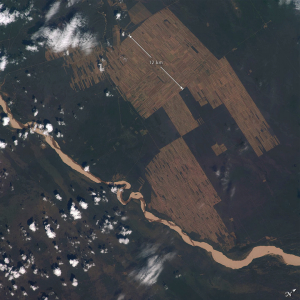
Government policies in some countries have fostered the exploitation of forest resources. Encouraging the population to develop forest land has opened the forest to continued degradation. In the 1990's the Bolivian Government began a large-scale program to increase the rate of forest removal for commercial agriculture (primarily soy and sugar cane, but also cocoa) on the Amazon Basin side of the Andean highlands. The dramatic effect of this action is seen in Figures BE21a and BE21b. Forest clearings began as small tracts perpendicular to access roads taking on a herringbone pattern when seen from the Space Shuttle in 1995. By 2008, the cleared area has greatly expanded. The impact of clearing on soil erosion and stream sediment load is evident in the brown, silt-laden Rio Parapetí that flows through the region.

The heavy seasonal rain of the monsoon forest poses a great danger, generating rapid runoff, mudflows and flash flooding. A result of unregulated deforestation, rivers become choked with sediment degrading the aquatic environment.
Deforestation has had a significant impact on indigenous cultures too. Six to nine million indigenous people inhabited the Brazilian rain forest in 1500. Today less than 1% of Brazil's 177 million people are full-blooded indigenous Indians (Source: US State Department). The loss of indigenous cultures destroys a wealth of knowledge about the environment in which they lived.


